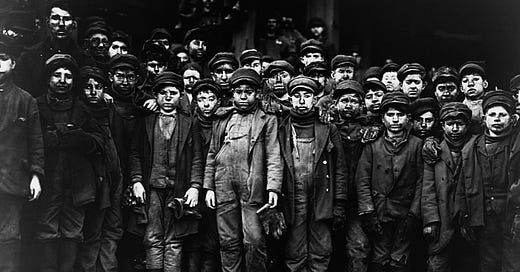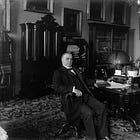

🪚 🚧 ⛏️ With corporate outlets obeying in advance, supporting independent political media is more important right now than ever. Public Notice is possible thanks to paid subscribers. If you aren’t one already, please click the button below and become one to support our work. ⛏️ 🚧 🪚
Trump surrogates have been fanning out to talk about how great it will be when factories return to the United States, which will happen magically and friction-free, all thanks to crushing tariffs.
Perhaps the most preposterous example of this talking point (so far) was served up last weekend by Commerce Secretary Howard Lutnick, who went on Face the Nation and hyped that “the army of millions and millions of human beings screwing in little screws to make iPhones — that kind of thing is going to come to America.”
But even if the Trumpian dream of returning assembly lines and the like to America was easily attainable — which it isn’t — those jobs would look nothing like the ones from the heyday of American manufacturing. Instead, thanks to the same administration currently banging on about their return, those jobs would be unsafe and unsustainable.
First, the idea that companies can plop a factory any old place in America and just start cranking out cars or jeans or widgets or whatever is untethered from reality. Large-scale factory building takes years and costs a ton. It also takes infrastructure, like roads and access to shipping routes.
To see what actually happens when Republicans are in charge of getting domestic manufacturing up and running, cast your eyes back to the Foxconn debacle. Wisconsin’s governor at the time, Scott Walker, promised Foxconn the moon to move to the Village of Mount Pleasant. In 2018, Trump showed up and used a stupid golden shovel to move a couple bits of dirt. But luring Foxconn with promised treats like $4 billion in tax breaks and water from Lake Michigan didn’t result in the promised 13,000 manufacturing jobs. Last time anyone checked, all that had been built was a weird 100-foot sphere that is available for event rental. The losers here were state and local governments, which spent half a billion dollars getting the Foxconn site ready.
There’s also the fact that Trump promised this golden age of manufacturing, mining, and good stateside jobs during his first term. In reality, he sat on his hands while companies offshored and the manufacturing sector shrunk. He was also going to bring back coal, which also didn’t turn out so great, with US coal production in 2019 coming in at its lowest level since 1978. (Trump held a big event at the White House yesterday touting once again to bring back coal, which shows that orange dogs can’t learn new tricks.)
But let’s pretend that this time, everything goes right and happens super fast, and factories are ready to start pumping out products in record time. What would those jobs look like?
Bad. They’ll look bad. There’s really no other way to put it.
Trump keeps talking about the 1890s for a reason
People look back on the golden age of American manufacturing with fondness because it provided the elusive “good jobs at good wages.” To the extent that was actually true, it was thanks to an interlocking series of policies that Republicans happen to hate.
So, the same people in the administration promising the return of domestic manufacturing and increased coal mining are also dismantling measures that would help keep workers safe. They’re the same people who don’t believe in a minimum wage that could feed a family. They’re the same people who want to see unions crushed.
Conservatives have made it a decades-long project to undo worker protections. Indeed, that project well predates the always-fetishized 1950s. They’ve been furious since what is known as the Lochner era ended back in 1937, and they’ve been trying to drag us back to a deregulated nightmare ever since. The second Trump administration might just be their chance to pull it off.
For a stretch of about forty years, from 1897 to 1937, the United States Supreme Court made the world a veritable paradise not for workers, but for employers. You’ll note that Trump routinely invokes 1870 to 1913 — the Gilded Age — as a time of unmatched American prosperity.
That was indeed true for rich people. The Rockefellers of the world got exceedingly wealthy, in no small part because politicians who were in thrall to them helped by doing things like crushing labor movements and allowing corruption to run rampant.
Since conservatives love to dress up their brutality and corruption in high-minded ways, they frame the Lochner era as one where economic liberty was greatest, as was the “liberty to contract.” That sure sounds nice. Workers should definitely have the liberty to contract. Except in this instance, it actually meant “liberty for your employer to exploit you.”
A note from Aaron: Working with brilliant contributors like Lisa takes resources. If you aren’t already a paid subscriber, please sign up to support our work.
The Lochner case involved a New York regulation that prevented bakery workers from working more than 60 hours per week or 10 hours per day. The idea was to provide some protection against grueling and largely unregulated working conditions. Lochner, the bakery owner, sued, saying that the regulation interfered with his liberty to contract with employees.
In striking down the regulation, the Supreme Court explained they were really doing it for the workers: “The employee may desire to earn the extra money which would arise from his working more than the prescribed time, but this statute forbids the employer from permitting the employee to earn it. The statute necessarily interferes with the right of contract between the employer and employees.”
While that statement may indeed be true factually, it’s laughable legally. It’s based on the notion that employers and workers have the same bargaining power, and hey, if those workers want to work over 60 grueling hours in a bakery or in dangerous conditions, who are we to say no? But workers don’t have the same power as employers, and everyone knows it. What the Lochner holding really meant was that states couldn’t pass laws to protect workers, wrapped in the fiction that the workers themselves wanted that and would somehow flourish in unregulated industrial jobs.
These are the same arguments conservatives still trot out today about the so-called “right to work.” Those laws are spun as pro-worker, freeing them from the tyranny of unions and allowing them the joy of contracting directly with their employer.
But what right to work laws are really meant to do is break unions. They prohibit unions from requiring non-members to pay a fair share fee that covers the cost of collective bargaining. Those fees are assessed because non-members benefit from that bargaining, getting the same contract and protections as union members. (The greater dues charged to union members also cover things like political activism.) But if non-members don’t have to pay anything to get the benefit of collective bargaining, why stay in the union at all?
States with right-to-work laws see drops in union membership, which is precisely the intent. They also see lower wages, worse benefits, and increased workplace fatalities. Such freedom!
Though the Lochner case gave the era its name, it was just one of many worker protections struck down by the Supreme Court in the early 1900s. The Court also struck down minimum wage laws, child labor laws, and mining regulations. It wasn’t until 1937, when the Court finally upheld a New Deal-era minimum wage law, that the fiction of worker freedom was finally broken. After that, Franklin Delano Roosevelt passed things like the Fair Labor Standards Act, which set wage and hour restrictions, and the very beginnings of workplace safety regulations, though it took until 1970 to pass the Occupational Safety and Health Act.
But while most of us appreciate laws that limit how much an employer can exploit you or put you in danger, conservatives most certainly do not.
In 2013, Sen. Rand Paul praised Lochner as a “wonderful decision” and complained that “someone cannot deprive you of determining how long your working hours are without due process.” The Heritage Foundation has dressed up its desire for states to eliminate safety and licensing requirements as emblematic of the economic liberty the Founders so cherished. Project 2025 — the thing the mainstream media spent last year pretending Trump knew nothing about — proposed overhauling overtime regulations to benefit employers, exempting many businesses from OSHA fines, and letting teenagers work in dangerous occupations.
The Trump administration has hit the ground running on making these dreams of an unregulated paradise come true. Trump’s regulatory freeze has stopped all government rule-making and indefinitely suspended OSHA’s efforts to create national workplace heat safety regulations. That’s not much of a surprise given Trump’s pick to lead OSHA, David Keeling. Keeling was head of safety at UPS from 2018 to 2021, and during his tenure, injuries from heat exposure were the most common safety incidents.
The administration has also indefinitely paused meetings of the Federal Advisory Council on Occupational Safety and Health, which is supposed to provide recommendations about workplace safety to the secretary of labor. That council was established by federal law, but Trump of course regards adherence to those as optional.
During his first term, Trump tried to roll back protections for 16- and 17-year-olds so they could have the privilege of operating dangerous patient lifts in hospitals and nursing homes without any pesky adult supervision. He scrapped a rule that required employers to provide detailed injury reports electronically, with the comical assertion that doing so violated the privacy of workers. And he weakened an Obama-era overtime rule so that it covered millions fewer workers.
The American nightmare
Now, imagine that shiny new factory that somehow appears very quickly. And imagine no protections for heat exhaustion, no restrictions on teenagers working there, no requirements for detailed injury reports, and no overtime. Then imagine no union and no collective bargaining, which means few to no benefits and definitely no pension.
Suddenly, it doesn’t seem like one of those jobs from days gone by where someone could support their family. Indeed, Trump just killed the $17.75 minimum wage requirement for federal contract workers, and there’s no reason to think he’d support anything that set a prevailing wage for these imaginary factory jobs.
Cabinet members are desperately trying to make this state of affairs sound good. Treasury Secretary Scott Bessent told Tucker Carlson that the tens of thousands of laid-off federal workers can just get jobs in the stateside factories that will spring up in the wake of Trump’s brutal tariffs, which is nearly as absurd as Lutnick’s excitement about iPhones being made in America.
Trump, meanwhile, is around musing that miners love working in the mines so much they’d turn down a penthouse on 5th Avenue just to keep that job. (Watch below.)
All of these things are patently ridiculous and show that the administration has no real plan or intention of fostering a world where factory jobs would be well-paid and safe. It’s just brutality and disregard for workers all the way down.
That’s it for today
We’ll be back with more tomorrow. If you appreciate today’s newsletter, please support us by signing up. Paid subscribers make Public Notice possible.
Thanks for reading.













Whenever I have heard Trump talk about coal, and this was in his first term as well, he projects a particular assumption he holds (and when he holds an assumption it is immovable), that when it comes to the people of Appalachia, well, coal mining is all they are good for. They don't "really" want to do anything else, and, unspoken but held, they're not really capable of anything else. High-skilled manufacturing? Nah. Science and engineering? No way. He sees coal miners, and persuades himself that they are actually pretty happy to live (and die) that way forever. The natural order of things.
Both of my grandfathers immigrated to the U.S. at the turn of the last century. In looking for work, along with thousands of other new male immigrants, they took jobs in the coal mines of northern Pennsylvania. It wasn’t long before each left this harsh work environment for other jobs. One grandfather had a career as a butcher with an A&P grocery store in Binghamton, N.Y. The other, my father’s dad, also settled in Binghamton and had a career with Endicott Johnson , a shoe manufacturer. I remember how he used to say in broken English, with a grin on his face: “E.J. OK”
Trump and his cabinet of oligarchs are slime balls and entitled pigs. They will get their just due.